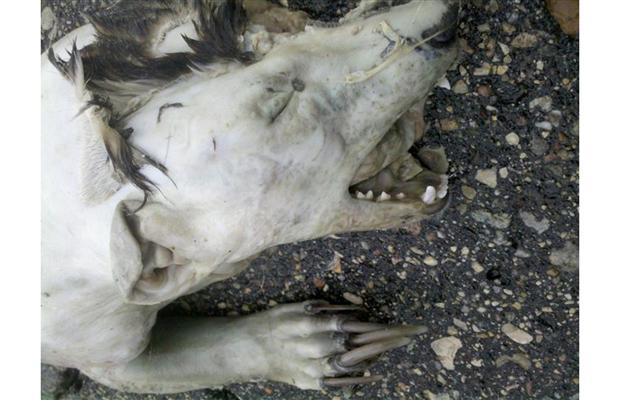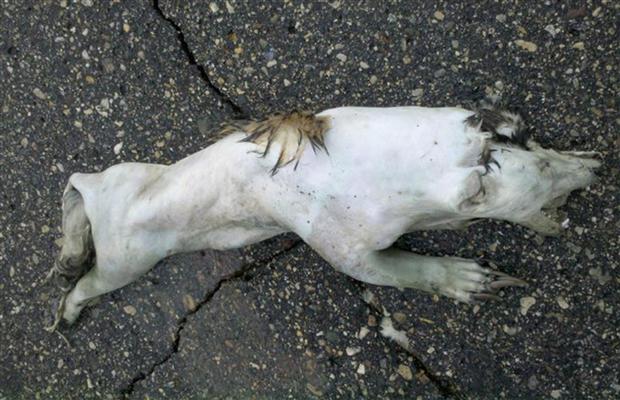Minnesota Mystery Roadkill
Posted by: Loren Coleman on August 5th, 2011


The dead white mammal was spotted this week on a Douglas County, Minnesota road with five claws, dark tufts of hair on its back and head and long toenails. Since the Montauk Monster of 2008, every incident of finding a dead and decaying, initially unidentified, carcass appears to excite local media.

The infamous Montauk Monster of 2008.
About Loren Coleman
Loren Coleman is one of the world’s leading cryptozoologists, some say “the” leading living cryptozoologist. Certainly, he is acknowledged as the current living American researcher and writer who has most popularized cryptozoology in the late 20th and early 21st centuries.
Starting his fieldwork and investigations in 1960, after traveling and trekking extensively in pursuit of cryptozoological mysteries, Coleman began writing to share his experiences in 1969. An honorary member of Ivan T. Sanderson’s Society for the Investigation of the Unexplained in the 1970s, Coleman has been bestowed with similar honorary memberships of the North Idaho College Cryptozoology Club in 1983, and in subsequent years, that of the British Columbia Scientific Cryptozoology Club, CryptoSafari International, and other international organizations. He was also a Life Member and Benefactor of the International Society of Cryptozoology (now-defunct).
Loren Coleman’s daily blog, as a member of the Cryptomundo Team, served as an ongoing avenue of communication for the ever-growing body of cryptozoo news from 2005 through 2013. He returned as an infrequent contributor beginning Halloween week of 2015.
Coleman is the founder in 2003, and current director of the International Cryptozoology Museum in Portland, Maine.










Dead dog.
American badger.
Well what do you know! That there is a Muskeg Molverine. Seems like every other year or so a lumberjack goes missing and all they find is a mound of dirt. They dig too fast to catch them. I don’t think even the Minnesota Zoo has a pair. What it is doing on the prairie out by Alexandria I do not know. Maybe it had rabies.
Judging by the claws, it looks to be a badger carcass.
I wish people would include something to add a sense of scale.
Guessing that the large crack above the back might be 1/4 inch, gives a body length of 18 inches or so.
The long claws, the off the wall guess at body size, I’d guess its an immature badger.
What dark fur there is would match.
It’s either a dog or a Badger like EOC says, either way with mange. The badger seems more likely considering the immense neck and ginormous claws. The claws reminded me of depictions of Ceratogaulus (not sure if that is spelled right), a horned gopher like animal which had immense claws and two horns on its head: No way that could be a Ceratogaulus, just making a comparison.
It is definitely a mustelid, probably the American badger, Taxidea taxus.
yup dog or badger,,, just my 2 cents
If it had been Wisconsin I’d have said it was an albino bodag…though I suppose one could have wandered across state lines…
Wow, do any of you that say it’s a dog actually own a dog? Dogs don’t have 5 toes on their front paws. They have 4 and a dew claw, sometimes the dew claw is surgically removed. I don’t know much about the anatomy of wolverines or badgers so I won’t make an uneducated guess on that, unlike you ‘dog’ people.
Badger with mange…the ears being off to the side and low on the head is all you need to see, but the body is also totally badger in it’s dimensions and details like claws etc.
The badger identity is nearly 100% sure. The ramaining dark and white fur on the the head looks also strikingly similar to those of a badger. There is no mange necessary to explain the missing fur. It is quite common that a carcass loses its hair during decomposition, especially when it it humid. The skin would look totally different if the badger would have really suffered from mange.
I agree with Sordes, if it had mange the skin would be gray and rough in appearance, not smooth and white. My first thought was badger as well.
Definately looks somewhat badger-ish.
It seems like you can’t hit a possum without some newstory finding the body and crying wolf, or in this case, chupacabra.
Something doesn’t ring right about this. I’m thinking its staged to look more mysterious than it actually is.
I agree its a common animal (like a badger) but I have to wonder about the striking lack of fur. If it was photographed where it was found I’d expect to see some remnants of fur and signs of decomposition or tire drag on the ground. Also the ground looks very wet, although that might simply be what the roads look like there. I can see from the photo that their tarmac has much larger aggregate than ours does.
I think someone got bored and staged a pic to keep themselves and their readers occupied for a bit.
This is obviously a Northern Albino Chupacabrah …. or maybe MAYBE! a badger. But I’m leaning towards a Chupacabrah.
🙂
😛
It’s a Honey badger and it don’t care.
If it is indeed a honey badger it wouldn’t care as RWRidley has reminded us.
dead, bloated, fur-less badger
It would certainly appear to be a badger.
It looks to me like this one has been dead in the water for a while – This bloater was a floater!
I doubt that this was a road kill (not very mangled), and I also doubt that the photo is in-situ of where the body was found.
A simple hair analysis will clear this one up, no need for expensive DNA testing here.
Heres the story from the Huffington Post
Minnesota Department of Natural Resources (DNR) officials are scratching their heads over an unidentified dead mammal that was first spotted July 31 on a Douglas County road.
The creepy-looking all white creature with five claws on its front paws, long toenails and dark tufts of hair on its back has prompted speculation that Minnesota is home to the legendary chupacabra, KSAX-TV reports.
Lacey Ilse was driving close to her home on County Road 86, near Alexandria, when she first saw the dead carcass.
“We saw something in the middle of the road, and we knew it wasn’t a dog or a cat, because it didn’t have hair,” Ilse told KSAX-TV.
“It had a clump of hair and all the rest was just white skin. Its ear was all mis-shaped. To me, it looked half-human,” Ilse said.
DNR area wildlife supervisor Kevin Kotts said the animal closely resembles a badger, although the creature’s tail is longer than a typical badger.
“It’s got five long front claws on each of its front feet, which would be characteristic of a badger,” Kotts told the TV station. “I ran the pictures past a few other DNR folks that have a lot of trapping and/or furbearer experience, and they all said it’s hard to be 100 percent sure what it is … but if it’s a Minnesota animal, it’s probably a badger.”
Chupacabras, or “goat suckers,” are creatures said to live in Mexico, Puerto Rico and in different parts of the United States. The animals, described as something between a dog and a wolf, reportedly kill and suck the blood out of livestock.
Last month, a Texas teenager claimed to shoot and kill a chupacabra. Results have not yet been announced from hair and skin samples taken of the animal.
Most wildlife experts believe the weird-looking animals are coyotes afflicted with mange, caused by an infection of tiny parasites that results in their hair falling out and leaving them with shriveled skin.
The body of the Minnesota chupacabra suspect has been frozen at the Glenwood DNR office and officials may soon do a DNA test to hopefully identify the mysterious roadkill.